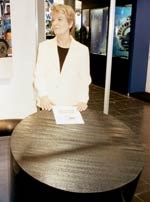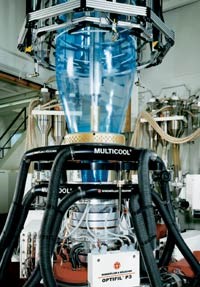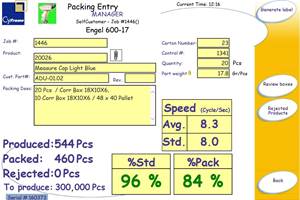A Show Full of Surprises For Every Application
It doesn’t matter whether you extrude blown or cast film, sheet, pipe, profiles, or foam—the K 2001 show held something exciting and unexpected that will open your eyes to new possibilities.
It doesn’t matter whether you extrude blown or cast film, sheet, pipe, profiles, or foam—the K 2001 show held something exciting and unexpected that will open your eyes to new possibilities. A brand-new kind of energy-saving extruder was just a start. There was also a new extrusion process that can make stiff or flexible products (or both) from the same PE resin.
Other news included extrusion of ceramic micro-tubes and giant rods of 3 ft diam. Simultaneous coextrusion of crosslinked PE with barrier resins was also shown, as was a pipe die that switches from one to two layers. For cast film and sheet, a “markless” hauloff drive uses toothless “gears.” Foam PVC sheet widths have stretched almost to 10 ft, and PE/PS foam coextrusion is now possible. In blown film, bristled rollers handle film gently, while segmented air flow now controls gauge both inside and outside the bubble.
Look, no heater bands!
A new extruder concept isn’t something you see every day or at every trade show. At the preceding K’98 exhibition, Nextrom’s cone extruder made a dramatic first appearance. This unusual technology replaced a screw with a grooved spinning cone. At K 2001, another revolutionary extrusion concept was shown for the first time, but without commercial fanfare. It was developed and displayed by the University of Paderborn, Germany. It’s a stubby, 6:1 L/D extruder that runs at up to 700 rpm, versus up to 300 rpm for a typical single screw. It’s said to be extremely energy efficient because it melts plastic so rapidly that no heater bands are required on the barrel. Because the extruder is so compact, applications could include coextrusion where space is constrained.
The back end of the screw looks like a conventional conveying section. But after only two turns, the root diameter quickly expands almost to the full width of the barrel, effectively creating a barrier flight, after which, the remaining 4D consist of narrow, tightly spiraled flights.
Essential to the screw’s plastication and dispersion functions are spirals cut into the inside of the barrel in a direction opposing the spiral flights in the screw. The barrel starts with a grooved feed throat, then has a smooth bore over the conveying flights and a spiral groove over the last 4D (see photo).
The device is still in early development and the university seeks backing from big machine builders. Krauss-Maffei and Reifenhauser each holds a related patent and has expressed interest in supporting the research, the university says, but there is no formal agreement yet.
Meanwhile, Nextrom’s Conex technology was spun off last year into a separate development company, Conex Technologies S.A., now housed at the university of Lausanne, Switzerland. It is also seeking new investors. Up to now, the cone extruder has been used only by its original developers—Nextrom, Uponor, and NK-Cables—for pipe and fiber optic cable coating. Last August, the first unit was sold to an outside customer—Nexans, a wire and cable maker in Nurnberg, Germany.
Novelty in pipe/profiles
The K show brought an unexpected trove of new pipe and profile technologies. A novel “self-reinforced extrusion” process for medical profiles, introduced by the University of Erlangen-Nurnburg, Germany, makes soft or stiff products from the same resin or can alternate soft and hard sections in an extrudate. The university showed samples of stiff and flexible rods made of the same HDPE, one self-reinforced, the other not.
The process uses a conventional single-screw extruder and no special additives. It creates a crystalline structure that alternates micro-segments of flow-induced nucleation with segments of pressure-induced nucleation. Flow-induced nucleation is done by accelerating extensional flow that stretches plastic molecules into rod-shaped crystalline structures. Pressure-induced nucleation does the opposite, creating a compact crystalline structure.
The result is a profile with up to 14 times higher modulus. Haul-off speed is slow: only 2 to 8 in./min., depending on profile dimensions. But since the first target project is a small medical catheter, output isn’t a big issue. The goal is to replace current catheter tubes made using metal inserts and multilayer or sequential coextrusion with a dual-durometer tube made seamlessly of one resin.
Gimac of Italy (represented here by Citsco, Lancaster, S.C.) showed another novelty: extrusion of ceramic micro-tubes with one or more lumens and OD as small as 80 microns. The ceramic extrusion process was developed and patented by Gimac and the University of Bologna, Italy. Micro-tubes are made by extruding a silicone pre-ceramic compound (supplied by GE Silicones or Wacker Silicones) and then pyrolizing the “green” extrudate in a furnace to convert it to a true ceramic. The tubing shrinks in the process. The smallest tubing sizes may require coextruding the pre-ceramic with a thermoplastic for support. The plastic layer is burned away in the furnace.
At the other size extreme, Reinert-Ritz GmbH, a custom profile extruder in Klausheide, Germany, broke a world record with its 35-in.-diam. solid rod of HDPE. It took three days to extrude a meter of it, but the biggest problem wasn’t extruding such a mass, but cooling it afterward, says a company spokesman. The previous record for a solid profile was 27.7 in. diam.
A novel three-layer pipe coextrusion line from Tecnomatic SpA in Azzano San Paolo, Italy, coextrudes crosslinked PE (XLPE) simultaneously with EVOH and a tie layer. Normally, XLPE pipe is extruded first, cooled, coated with adhesive, cooled again, coated with EVOH, and cooled a third time. A key problem is that the surface layer of EVOH sticks to calibrators. Tecnomatic developed a new way to cool and calibrate the three layers at once, with a water-lubricated prechamber in a 19.5-ft-long vacuum calibration tank. Tecnomatic has two commercial installations in Europe.
In PVC pipe, Krauss-Maffei has developed new twin-screw extruders that are said to raise output by 17% while reducing screw and barrel wear. The new models have 36:1 L/D instead of the previous 26:1 and have two vent zones instead of one. The first vent removes air that was entrained in the powder blend, which allows the powder to be compressed and achieve better heat transfer, K-M says. Next, a vacuum vent removes any remaining volatiles from the melt.
Krauss-Maffei also showed a novel adapter that converts a monolayer pipe die to make two-layer pipe. Developed with the University of Paderborn, the adapter has two plates with several coathanger distributors around the edges. It can connect to a satellite striping extruder.
Meanwhile, Drossbach GmbH (U.S. office in Exeter, N.H.) showed the first corrugating system to move mold blocks with robots instead of on tracks or chains. Robotic mold transfer is so much faster than chains that Drossbach can form 70-in.-diam., dual-wall corrugated pipe with only five pairs of mold blocks instead of the usual eight to 12 pairs. The first prototype was delivered last June to Advanced Drainage Systems in Columbus, Ohio. A second went to a processor in Florida, and three more are on order.
Omipa S.p.A. in Morazzone, Italy, has built three dies for PP hollow profiled sheet that are 10.5 ft wide, believed to be the world’s largest. Previously, the widest hollow profiled-sheet die was 9.2 ft—also built by Omipa.
Cast film & sheet news
For oriented films, Bruckner Maschinenbau (U.S. office in Greenville, S.C.) is testing its LISIM simultaneous biaxial stretching system on seven-layer PP barrier film. The advantage is that nylon and EVOH barrier layers reportedly can be stretched far thinner with the simultaneous method than with two-step biaxial orientation.
In coextrusion, Kuhne (Norwich, Conn.) recently announced its most complex feedblock to date. It is suitable for up to nine layers plus edge encapsulation and uses as few as five extruders. Typically this configuration would take six to nine extruders.
Verbruggen N.V. in Temse, Belgium, showed a new feedblock with fixed restrictor bars. Model MA-CAFR is a less expensive variation on its MA-CARR feedblock, introduced at K’98, which has a rotating restrictor bar. Verbruggen is believed to be the only extrusion tooling maker to use a restrictor bar at the meeting point of the layers to control flow. It replaces flow pins and means fewer obstructions in the feedblock, thus avoiding dead spots.
Seide Engineering in Buchholz, Germany, unveiled a prototype of an “absolutely markless” roll drive that uses planetary “gears” without teeth, thus avoiding periodic toothmarks on the film. Instead, smooth rolls function like gears. They are driven by a smooth metal cushion, flexed by hydraulic pressure from a ring-shaped device in order to make radial contact pressure between the rolls. Seide delivered the first roll stack with “markless” drives in November for beta testing.
Eurotherm Gauging Systems Inc., Billerica, Mass., launched its first inexpensive gamma-backscatter thickness gauge for sheet. Until now, the company focused on high-end film applications with infrared and beta gauges. The new gamma-type gauge sells for about $50,000 installed. Eurotherm says its version uses a new detector design that is 50% more accurate than other gamma gauges. It will be available in the second quarter.
News in blown film
Windmoeller & Hoelscher (Lincoln, R.I.) gave the first show demonstration of a dedicated, high-output, three-layer coex line with tandem air rings. The tandem arrangement uses a single-lip air ring over the die and a dual-lip ring about 6 in. higher up. Using two Multicool air rings (plus IBC), the 11-in. die ran at 35 lb/hr/in. (1200 lb/hr total) vs. 22 lb/hr/in. with one dual-lip air ring.
Tandem air rings with IBC are used on dedicated, high output lines. They require a much smaller die diameter for the same layflat because the bubble has two blow-up ratios. Thus an 11-in. die with two air rings makes a layflat up to 63 in. wide.
Although newly available from W&H, tandem air rings have been used selectively in North America for over 15 years under two U.S. and Canadian patents belonging to Macro Engineering & Technology Inc., Mississauga, Ont. W&H believes it is not in violation of Macro’s patents and intends to market the system worldwide.
A new automatic gauge-control system is said to be the first to use circumferentially segmented air flow both inside and outside the bubble. It comes from a two-year-old German company, K design GmbH, represented by Future Design Inc. in Brampton, Ont.
Ghioldi Srl in Nizzolina, Italy, gave a rare demonstration of blowing film with biodegradable, starch-based Mater-Bi resin from Novamont in Italy. Ghioldi has worked with Novamont to develop a dedicated machine for the material, which has a very low BUR. Ghioldi’s equipment, with or without IBC, can achieve nearly the same output of Mater-Bi as for conventional LDPE, the company says. The film is used for compostable bags.
As blown-film quality gets better and better, one of the last areas to make big gains is winders. Several machine builders showed improved winding technology at K. Reinhold Maschinen-und-Geratebau GmbH of Lengerich, Germany, showed a new lower-priced version of its high-end ASK winder. It is said to retain 90% of the functionality for 70% of the price. The SRKW winder is a centrally driven model with the same patented vacuum cutting drum as the ASK model. It applies vacuum just as the cutting knife comes out of the drum to make a clean, right-angle cut to start the reel without foldback.
Also new from Reinhold is a non-contacting bubble cage with smaller, more closely spaced air holes than usual. The result is a more uniform air cushion and less chance of film contacting the frame. The first installation is on a 10-layer coex line.
Only weeks before the show, Kiefel Extrusion (Wrentham, Mass.) bought the winder division of Maier Heidenheim, a German maker of turret and orbital winders. Last year, Kiefel purchased Wintech, a maker of center/surface/gap winders. Kiefel showed a Wintech winder with independently driven rolls and a contact roller that retracts as a film roll grows to apply constant lay-on pressure.
Kiefel also showed for the first time a collapsing frame whose rollers were covered with nylon bristles like a toothbrush. The bristles contact less of the bubble surface than a smooth roller, so they transfer little heat and don’t scratch, Kiefel says.
Macchi Srl of Italy, which recently opened an office in Burlington, Ont., showed off the first bubble cage it ever made. Previously, Macchi’s cages were outsourced.
News in foam extrusion
Friul Filiere SpA of Buia, Italy, showed a new flat, hollow profile die capable of extruding foamed PVC door panels with hollow sections at 3.5 ft/min, reportedly the world’s fastest. Last year, the company delivered nine such lines to Dalien, China, to what is said to be the world’s biggest PVC door plant. It processes 26 million lb into 500,000 doors per year. Production there reportedly averages 3.3 ft/min. The monolayer doors have 0.5-g/cc density inside an 0.8-g/cc skin, created by quick cooling in the die and calibrators.
What’s the widest foamed PVC sheet in the world? Early last year, Krauss-Maffei held the record when it shipped a production line for sheet 6.5 ft wide and 10 mm thick to Veka in Germany. The system uses the Celuka process to yield an internal foam density of 0.6 g/cc and a solid skin.
Then Kommerling Kunststoff GmbH of Germany assembled a production line for 9.8-ft-wide foamed PVC panels 2-10 mm thick, setting a new record. The foamed panel comes out of a parallel twin-screw machine and is cooled over calendering rolls. Density of the panels runs 0.55 to 0.7 g/cc, depending on thickness.
LMP Impianti in Italy, a unit of Owens Corning with U.S. offices in Talmadge, Ohio, brought to the show a new high-output corotating twin-screw for PS foam. Model RX 100 (132 mm) has a new gearbox and AC motor. It is said to process 770 lb/hr vs. 440 lb/hr for the previous model with DC drive. It uses oil-cooled screws and a butane blowing agent.
Davis-Standard Corp., Pawcatuck, Conn., showed the prototype of a new automatically self-adjusting annular die for coex PE/PS foam. Gauge is adjusted automatically by pressure from 12 pistons around the circumference of the die.
Related Content
Medical Tubing: Use Simulation to Troubleshoot, Optimize Processing & Dies
Extrusion simulations can be useful in anticipating issues and running “what-if” scenarios to size extruders and design dies for extrusion projects. It should be used at early stages of any project to avoid trial and error and remaking tooling.
Read MoreUse Interactive Production Scheduling to Improve Your Plant's Efficiencies
When evaluating ERP solutions, consider the power of interactive production scheduling to effectively plan and allocate primary and secondary equipment, materials and resources on the overall production capacity of the business and conclude that this is a key area that cannot be overlooked.
Read MoreUnderstanding Melting in Single-Screw Extruders
You can better visualize the melting process by “flipping” the observation point so the barrel appears to be turning clockwise around a stationary screw.
Read MoreHow Screw Design Can Boost Output of Single-Screw Extruders
Optimizing screw design for a lower discharge temperature has been shown to significantly increase output rate.
Read MoreRead Next
Beyond Prototypes: 8 Ways the Plastics Industry Is Using 3D Printing
Plastics processors are finding applications for 3D printing around the plant and across the supply chain. Here are 8 examples to look for at NPE2024.
Read MorePeople 4.0 – How to Get Buy-In from Your Staff for Industry 4.0 Systems
Implementing a production monitoring system as the foundation of a ‘smart factory’ is about integrating people with new technology as much as it is about integrating machines and computers. Here are tips from a company that has gone through the process.
Read MoreFor PLASTICS' CEO Seaholm, NPE to Shine Light on Sustainability Successes
With advocacy, communication and sustainability as three main pillars, Seaholm leads a trade association to NPE that ‘is more active today than we have ever been.’
Read More



















